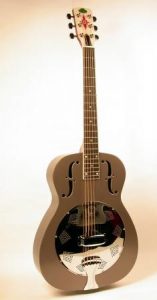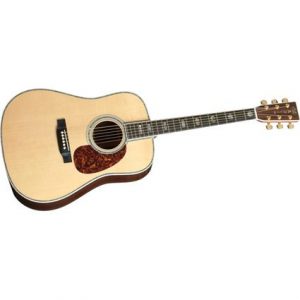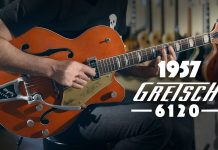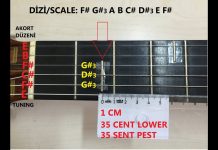The Electric Guitar has its predecessor in the classical guitar and its common history is in the section of guitar history. That history leads us into the twentieth century where we find a large technological and industrial development and the emergence of new musical genres like jazz and blues that made develop the instrument to adapt to the new needs of the twentieth century.
With the emergence of new musical styles and Big Bangs, it became necessary to increase the volume of the guitars, and in 1925 John Dopyera, the founder of the DOBRO (DOpyera BROthers) designed a guitar with metal box and inserted into its interior a resonant cone. The sound of these guitars was amplified by the cones, and not by the soundboard, which gave it a powerful and more metallic sound that was popular for blues, but not for other styles.

At that time, traditional guitars also tried to change in order to suit the new musical trends, and guitar makers tried to expand the sound of his traditional guitars by replacing the original strings with steel strings. To withstand the stress of new steel strings, traditional guitars had to evolve and increase its internal reinforcements, reinforcing the neck and extending the soundboard, what led to the birth of acoustic guitar as we know it. In the thirties, this kind of guitar was popularized by Martin with his model Dreadnought.

Dopyera guitar and steel string guitars increased the volume of the guitar, but not enough, so they began to investigate the possible amplification of sound volume by electronic amplification. Trying to amplify the sound by placing a microphone in front of the guitar didn’t work when playing with a group so the microphone also amplified the others instruments. So they began to investigate electromagnetic pickups.
The emergence of new musical genres like jazz and blues made develop the instrument to adapt to the new needs of the twentieth century.
An electromagnetic pickup consists of a magnet with a copper wire wound in the form of a coil. When the steel cord vibrates near the coil of the pickup, electricity is induced and connected to an amplifier it is transformed into sound waves.
The first electromagnetic guitar pickup was incorporated by the Rickenbacker brand in 1931 using a steel and tungsten magnet.
Guitar makers tried to expand the sound of his traditional guitars by replacing the original strings with steel strings.
Research with these types of pick ups was very productive, but produced feedback or reverberation in the hollow of the guitar sound box. This fact led to replace the original hollow body with solid bodies for guitars, but today we can still find electric guitars semi hollow body, mostly for jazz guitarists.

About who was the first to incorporate solid body on his guitars there are several theories, some consider it was Rickenbacker model, and others mention Les Paul with The Log, finally, others point to the independent musician Paul Bigsby. Whoever, the ingenious innovative ideas mentioned above led to the era of electric guitar in the way we currently know it and the birth of other musical styles like Rock’n’roll, for example.
Trying to amplify the sound by placing a microphone in front of the guitar didn’t work when playing with a group so the microphone also amplified the others instruments.
The previous ideas were used by Leo Fender to become the pioneer of mass production of solid body guitars. In 1948, he made the first mass production with the Broadcaster (Telecaster since 1952) and became the Henry Ford of electric guitar. Although this production, and this model was considered by his competitors like too simple so, obviously, the guitars were not constructed in an artisan way.
Fender had a very great acceptance among the population and its production continued fruitfully since its inception (in the fifties) to the present.
From then to now, thousands of millions of guitars have been sold worldwide, have proliferated brands and sub-brands (both Fender and Gibson made guitars from Japan) and we can find on the market today a large number of different guitars with different colors, shapes and pick ups (pick ups is widely available in the guitar amplification section.
The ingenious innovative ideas led to the era of electric guitar in the way we currently know it and the birth of other musical styles like Rock’n’roll, for example.
This range of forms, colors and models in guitars has turned them into symbols of a musical revolution throughout the twentieth century which persists alive in our society today.























